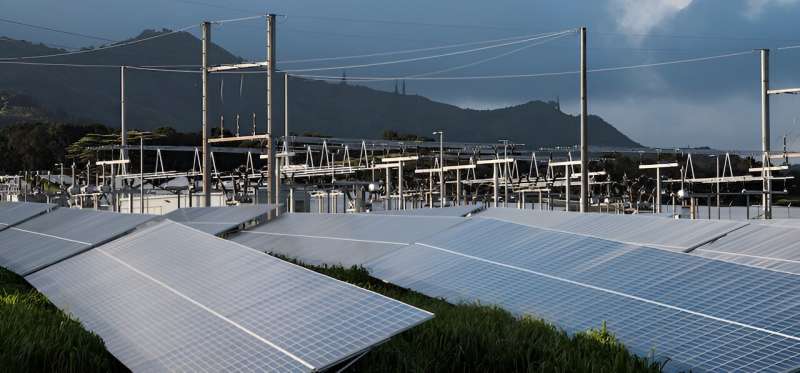
For photovoltaic (PV) systems—designed to operate over lifetimes of 20, 30, or even 50 years—small losses in energy production can add up to measurable differences over time. These differences can even determine whether a system operates at a profit or loss. Yet, small changes in energy production are frustratingly difficult to measure, especially in the noisy and often incomplete data of a PV system's production.
After four years of work, National Renewable Energy Laboratory (NREL) researchers have compiled a dataset from an unprecedented number of PV systems across the United States—data streams from 25,000 inverters across almost 2,500 commercial- and utility-scale PV sites in 37 states and U.S. territories. By cleaning and averaging data from a huge set of systems, the PV Fleet Performance Data Initiative (PV Fleet) offers a clearer-than-ever look at the health of the U.S. PV fleet and reveals some of the factors that are impacting its performance.
The work is published in the IEEE Journal of Photovoltaics.
Long-term degradation of US PV systems matches expectations
The performance of all solar panels is expected to degrade over time due to exposure to the elements. However, a range of factors drives degradation and the average rate of PV performance loss, which is often debated.
In 2022, in their first major finding, the PV Fleet team found a national median loss in performance of 0.75%/year, confirming similar values reported by previous studies that analyzed smaller datasets. Additionally, the new analysis discovered that systems in hotter temperature zones exhibited about twice as much performance loss as those in cooler climates (0.88%/year and 0.48%/year loss, respectively).
"This median loss in performance is a crucial number," said Chris Deline, a group manager for PV field performance at NREL and author on the PV Fleet publications. "First, it shows that our fleet of PV systems, on the whole, is not failing catastrophically, but rather degrading at a modest rate within expectations. It's important that we quantify this rate as accurately as we can, because this small but tangible number is used in almost all financing agreements that fund solar projects and provides critical guidance for the industry."
Extreme weather's frequency is increasing, but how big is its impact?
Extreme weather events—flooding, high winds, hail, wildfire, and lightning—can damage fielded PV systems and certainly contribute to long-term performance loss. But how large of an impact does extreme weather have across PV systems in the United States, and are the impacts seen more in the short term or long term?
In the new paper, researchers used the scale of the PV Fleet dataset to quantify some impacts of extreme weather. By comparing the performance of systems in the PV Fleet dataset against a National Oceanic and Atmospheric Administration (NOAA) map of extreme weather events, the researchers studied how each system's performance was affected when an extreme weather event occurred within 10 kilometers of its location.
For most systems, short-term impact of extreme weather is minimal
Overall, the short-term outages caused by extreme weather—such as outages due to PV modules being disturbed by strong winds or inverters being damaged by flooding—have a minimal impact on most systems. Over the 2008–2022 time range studied, the PV Fleet team found that the median outage length after an extreme weather event was two to four days, resulting in only a 1% median loss in annual performance. A very small number (12 systems out of 6,400) experienced much longer outages of two weeks or more.
Most outages occurred because of flooding and rain, followed by wind events. And most systems in the dataset only experienced one weather-related outage.
More information: Dirk C. Jordan et al, Extreme Weather and PV Performance, IEEE Journal of Photovoltaics (2023). DOI: 10.1109/JPHOTOV.2023.3304357
Citation: How extreme weather and system aging affect the US photovoltaic fleet (2024, January 25) retrieved 25 January 2024 from https://techxplore.com/news/2024-01-extreme-weather-aging-affect-photovoltaic.html
This document is subject to copyright. Apart from any fair dealing for the purpose of private study or research, no part may be reproduced without the written permission. The content is provided for information purposes only.
